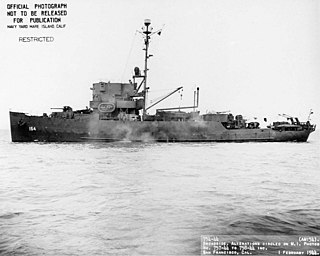
USS Admirable (AM-136) was the lead ship of her class of minesweeper built for the United States Navy during World War II. In commission from 1943 to 1945, she was transferred to the Soviet Navy in 1945 and served as T-331 until stricken in 1958.

USS Tide (AM-125) was an Auk-class minesweeper acquired by the United States Navy for the dangerous task of removing mines from minefields laid in the water to prevent ships from passing.
USS Bunting (AMc-7) was a coastal minesweeper in the United States Navy. She was named after the bunting, a seed-eating bird intermediate in size between starlings and finches.
USS Barrier (AM-150) was an Admirable-class minesweeper built for the United States Navy during World War II and in commission from 1944 to 1945. In 1945, she was transferred to the Soviet Union, serving in the Soviet Navy after that as T-335.
USS Bombard (AM-151) was an Admirable-class minesweeper built for the United States Navy during World War II and in commission from 1944 to 1945. In 1945, she was transferred to the Soviet Union, serving after that in the Soviet Navy as T-336.
USS Bond (AM-152) was an Admirable-class minesweeper built for the United States Navy during World War II and in commission from 1943 to 1945. In 1945, she was transferred to the Soviet Union and served after that in the Soviet Navy as T-285 and as BRN-37.
USS Augury (AM-149) was an Admirable-class minesweeper built for the United States Navy during World War II and in commission from 1943 to 1945. In 1945, she was transferred to the Soviet Navy, in which she served as T-334.
USS Astute (AM-148) was an Admirable-class minesweeper built for the United States Navy during World War II and in commission from 1944 to 1945. In 1945, she was transferred to the Soviet Navy, in which she served as T-333.

USS Candid (AM-154) was an Admirable-class minesweeper built for the United States Navy during World War II and in commission from 1943 to 1945. In 1945, she was transferred to the Soviet Union and served after that in the Soviet Navy as T-283.
USS Capable (AM-155) was an Admirable-class minesweeper built for the United States Navy during World War II. In 1945, she was transferred to the Soviet Union and then served in the Soviet Navy as T-339.
USS Captivate (AM-156) was an Admirable-class minesweeper built for the United States Navy during World War II and in commission from 1943 to 1945. In 1945, she was transferred to the Soviet Union and then served in the Soviet Navy as T-338.
USS Caravan (AM-157) was an Admirable-class minesweeper built for the United States Navy during World War II and in commission from 1944 to 1945. In 1945, she was transferred to the Soviet Union and after that served in the Soviet Navy as T-337.
USS Caution (AM-158) was an Admirable-class minesweeper built for the United States Navy during World War II and in commission from 1944 to 1945. In 1945, she was transferred to the Soviet Union and after that served in the Soviet Navy as T-284.
USS Paramount (AMc-92) was an Accentor-class coastal minesweeper acquired by the U.S. Navy for the dangerous task of removing mines from minefields laid in the water to prevent ships from passing.
USS Rhea (AMc-58) was a coastal minesweeper acquired by the U.S. Navy for the dangerous task of removing mines from minefields laid in the water to prevent ships from passing.
USS Ruff (AMc-59) was a coastal minesweeper acquired by the U.S. Navy for the dangerous task of removing mines from minefields laid in the water to prevent ships from passing.
USS Barbet (AMc-38) was an Accentor-class coastal minesweeper acquired by the U.S. Navy for the dangerous task of removing mines from minefields laid in the water to prevent ships from passing.
USS Brambling (AMc-39) was an Accentor-class coastal minesweeper acquired by the U.S. Navy for the dangerous task of removing mines from minefields laid in the water to prevent ships from passing.
USS Chimango (AMc-42) was an Accentor-class coastal minesweeper acquired by the U.S. Navy for the dangerous task of removing mines from minefields laid in the water to prevent ships from passing.

USS Enhance (AM-437/MSO-437) was an Aggressive-class minesweeper acquired by the U.S. Navy for the task of removing mines that had been placed in the water to prevent the safe passage of ships.



